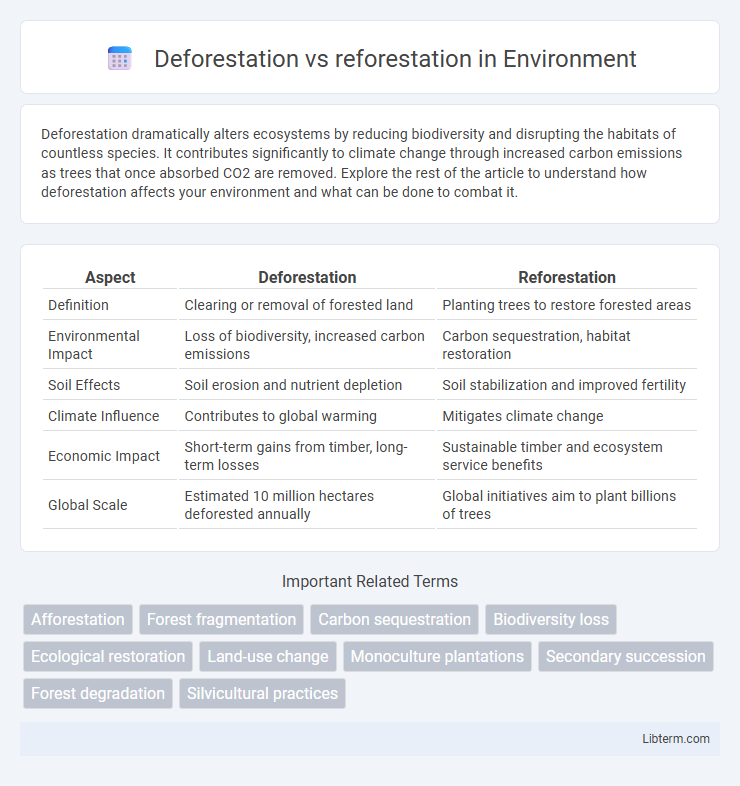Deforestation dramatically alters ecosystems by reducing biodiversity and disrupting the habitats of countless species. It contributes significantly to climate change through increased carbon emissions as trees that once absorbed CO2 are removed. Explore the rest of the article to understand how deforestation affects your environment and what can be done to combat it.
Table of Comparison
| Aspect | Deforestation | Reforestation |
|---|---|---|
| Definition | Clearing or removal of forested land | Planting trees to restore forested areas |
| Environmental Impact | Loss of biodiversity, increased carbon emissions | Carbon sequestration, habitat restoration |
| Soil Effects | Soil erosion and nutrient depletion | Soil stabilization and improved fertility |
| Climate Influence | Contributes to global warming | Mitigates climate change |
| Economic Impact | Short-term gains from timber, long-term losses | Sustainable timber and ecosystem service benefits |
| Global Scale | Estimated 10 million hectares deforested annually | Global initiatives aim to plant billions of trees |
Understanding Deforestation: Causes and Consequences
Deforestation, driven primarily by agricultural expansion, logging, and infrastructure development, results in significant biodiversity loss, disruption of water cycles, and increased carbon emissions. The removal of trees accelerates soil erosion and diminishes natural habitats, threatening countless plant and animal species. Understanding these causes and consequences is crucial for implementing sustainable land management and conservation strategies.
The Environmental Impact of Forest Loss
Deforestation leads to significant environmental impacts such as loss of biodiversity, disruption of water cycles, and increased greenhouse gas emissions due to carbon release stored in trees. Reforestation helps mitigate these effects by restoring habitats, improving air quality, and enhancing carbon sequestration, which plays a critical role in combating climate change. The balance between forest loss and gain directly influences ecosystem services vital for global environmental health.
Socioeconomic Drivers of Deforestation
Socioeconomic drivers of deforestation predominantly include agricultural expansion, driven by the demand for cash crops such as soybeans and palm oil, which are major contributors to forest loss in regions like the Amazon and Southeast Asia. Poverty and limited economic opportunities compel local communities to rely on logging and land clearing for subsistence farming, perpetuating deforestation cycles. Infrastructure development, including roads and urban expansion, further accelerates deforestation by increasing access to previously remote forest areas.
Reforestation Explained: Methods and Benefits
Reforestation involves planting trees in deforested areas to restore ecosystems, improve biodiversity, and sequester carbon dioxide. Common methods include natural regeneration, direct seeding, and planting nursery-grown seedlings, each chosen based on local climate and soil conditions. Benefits of reforestation extend beyond carbon capture, enhancing soil quality, preventing erosion, supporting wildlife habitats, and stabilizing the water cycle.
Carbon Sequestration: Deforestation vs Reforestation
Deforestation releases approximately 10-15% of global carbon emissions by destroying carbon-storing forests, significantly reducing the Earth's ability to sequester carbon dioxide. Reforestation enhances carbon sequestration by restoring forest biomass, with mature forests absorbing up to 2.6 billion tonnes of CO2 annually worldwide. Effective reforestation strategies can offset emissions and play a critical role in mitigating climate change by increasing long-term carbon storage in terrestrial ecosystems.
Biodiversity Effects: Habitat Loss and Restoration
Deforestation causes significant habitat loss, leading to declines in species richness and disrupting ecological networks essential for biodiversity. In contrast, reforestation efforts promote habitat restoration, enhancing species recovery and ecological resilience by recreating native vegetation and supporting wildlife corridors. The balance between deforestation and reforestation directly influences biodiversity, determining ecosystem stability and the survival of threatened species.
Climate Change: Mitigating Through Reforestation
Deforestation accelerates climate change by releasing stored carbon dioxide and reducing the Earth's capacity to absorb greenhouse gases, while reforestation mitigates climate change by restoring carbon sinks and enhancing biodiversity. Trees sequester carbon through photosynthesis, playing a critical role in lowering atmospheric CO2 levels and regulating global temperatures. Implementing large-scale reforestation projects can significantly counterbalance carbon emissions from deforestation and foster ecosystem resilience against climate impacts.
Successful Reforestation Case Studies
Successful reforestation projects in Costa Rica have restored over 3 million hectares of forest, reversing deforestation trends and enhancing biodiversity. In China, the Grain for Green program converted millions of hectares of degraded farmland into forest, significantly reducing soil erosion and improving carbon sequestration. Madagascar's reforestation initiatives have increased forest cover, supporting endangered species and benefiting local communities through sustainable resource management.
Policy Approaches to Forest Management
Effective policy approaches to forest management balance deforestation control and reforestation initiatives by implementing strict regulations on logging activities and promoting incentives for sustainable land use. Governments worldwide adopt frameworks such as payment for ecosystem services (PES), afforestation subsidies, and community-based forest management to enhance forest recovery and biodiversity conservation. Integrating satellite monitoring systems with legal enforcement ensures transparency and compliance, supporting long-term ecological and economic benefits.
The Future: Balancing Human Needs and Forest Conservation
Deforestation rates continue to threaten biodiversity, carbon storage, and climate regulation, while reforestation efforts help restore ecosystems and sequester atmospheric CO2. Sustainable practices integrating agroforestry, community-managed forests, and legal frameworks can reconcile human demands for agriculture, timber, and development with forest conservation goals. Innovations in satellite monitoring and ecosystem modeling enable precise assessment of forest dynamics, guiding policies that aim for a balanced coexistence between human activities and forest ecosystem health.
Deforestation Infographic

 libterm.com
libterm.com